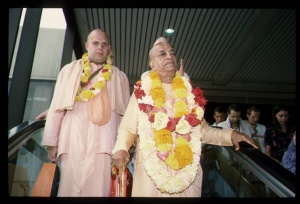SB 3.7.29: Difference between revisions
m (1 revision(s)) |
No edit summary |
||
| Line 1: | Line 1: | ||
{{info | {{info | ||
|speaker=Vidura | |speaker=Vidura | ||
|listener=Maitreya | |listener=Maitreya Ṛṣi | ||
}} | }} | ||
[[Category:Srimad-Bhagavatam - Canto 03 Chapter 07]] | |||
[[Category:Bhagavatam Verses Spoken by Vidura - Vanisource|030729]] | |||
<div style="float:left">'''[[Srimad-Bhagavatam]] - [[SB 3|Third Canto]] - [[SB 3.7: Further Inquiries by Vidura|SB 3.7: Further Inquiries by Vidura]]'''</div> | |||
<div style="float:right">[[File:Go-previous.png|link=SB 3.7.28]] '''[[SB 3.7.28]] - [[SB 3.7.30]]''' [[File:Go-next.png|link=SB 3.7.30]]</div> | |||
{{RandomImage}} | |||
==== TEXT 29 ==== | ==== TEXT 29 ==== | ||
<div | <div class="verse"> | ||
varṇāśrama-vibhāgāṁś ca | :varṇāśrama-vibhāgāṁś ca | ||
rūpa-śīla-svabhāvataḥ | :rūpa-śīla-svabhāvataḥ | ||
ṛṣīṇāṁ janma-karmāṇi | :ṛṣīṇāṁ janma-karmāṇi | ||
vedasya ca vikarṣaṇam | :vedasya ca vikarṣaṇam | ||
</div> | </div> | ||
| Line 16: | Line 22: | ||
==== SYNONYMS ==== | ==== SYNONYMS ==== | ||
<div | <div class="synonyms"> | ||
varṇa- | ''varṇa-āśrama''—the four divisions of social statuses and orders of spiritual culture; ''vibhāgān''—respective divisions; ''ca''—also; ''rūpa''—personal feature s; ''śīla-svabhāvataḥ''—personal character; ''ṛṣīṇām''—of the sages; ''janma''—birth; ''karmāṇi''—activities; ''vedasya''—of the Vedas; ''ca''—and; ''vikarṣaṇam''—categorical divisions. | ||
</div> | </div> | ||
| Line 23: | Line 29: | ||
==== TRANSLATION ==== | ==== TRANSLATION ==== | ||
<div | <div class="translation"> | ||
O great sage, kindly describe the divisions and orders of human society in terms of symptoms, behavior and the characteristics of mental equilibrium and sense control. Also please describe the births of the great sages and the categorical divisions of the Vedas. | O great sage, kindly describe the divisions and orders of human society in terms of symptoms, behavior and the characteristics of mental equilibrium and sense control. Also please describe the births of the great sages and the categorical divisions of the Vedas. | ||
</div> | </div> | ||
| Line 30: | Line 36: | ||
==== PURPORT ==== | ==== PURPORT ==== | ||
<div | <div class="purport"> | ||
The four statuses and orders of human | The four statuses and orders of human society—''brāhmaṇas'', ''kṣatriyas'', ''vaiśyas'' and ''śūdras'', as wall as ''brahmacārīs'', ''gṛhasthas'', ''vānaprasthas'' and ''sannyāsīs''—are all divisions of quality, education, culture and spiritual advancement attained by practicing control of the mind and the senses. All these divisions are based on the particular nature of each individual person, not on the principle of birth. Birth is not mentioned in this verse because birth is immaterial. Vidura is famous in history as born of a ''śūdrāṇī'' mother, yet he is more than a ''brāhmaṇa'' by qualification because he is seen here to be the disciple of a great sage, Maitreya Muni. Unless one achieves at least the brahminical qualifications, one cannot understand the Vedic hymns. ''Mahābhārata'' is also a division of the ''Vedas'', but it is meant for women, ''śūdras'' and ''dvija-bandhus'', the worthless children of the higher section. The less intelligent section of society can avail themselves of the Vedic instructions simply by studying the ''Mahābhārata''. | ||
</div> | </div> | ||
__NOTOC__ | |||
<div style="float:right; clear:both;">[[File:Go-previous.png|link=SB 3.7.28]] '''[[SB 3.7.28]] - [[SB 3.7.30]]''' [[File:Go-next.png|link=SB 3.7.30]]</div> | |||
__NOTOC__ | |||
__NOEDITSECTION__ | |||
Revision as of 12:57, 4 May 2021

A.C. Bhaktivedanta Swami Prabhupada
TEXT 29
- varṇāśrama-vibhāgāṁś ca
- rūpa-śīla-svabhāvataḥ
- ṛṣīṇāṁ janma-karmāṇi
- vedasya ca vikarṣaṇam
SYNONYMS
varṇa-āśrama—the four divisions of social statuses and orders of spiritual culture; vibhāgān—respective divisions; ca—also; rūpa—personal feature s; śīla-svabhāvataḥ—personal character; ṛṣīṇām—of the sages; janma—birth; karmāṇi—activities; vedasya—of the Vedas; ca—and; vikarṣaṇam—categorical divisions.
TRANSLATION
O great sage, kindly describe the divisions and orders of human society in terms of symptoms, behavior and the characteristics of mental equilibrium and sense control. Also please describe the births of the great sages and the categorical divisions of the Vedas.
PURPORT
The four statuses and orders of human society—brāhmaṇas, kṣatriyas, vaiśyas and śūdras, as wall as brahmacārīs, gṛhasthas, vānaprasthas and sannyāsīs—are all divisions of quality, education, culture and spiritual advancement attained by practicing control of the mind and the senses. All these divisions are based on the particular nature of each individual person, not on the principle of birth. Birth is not mentioned in this verse because birth is immaterial. Vidura is famous in history as born of a śūdrāṇī mother, yet he is more than a brāhmaṇa by qualification because he is seen here to be the disciple of a great sage, Maitreya Muni. Unless one achieves at least the brahminical qualifications, one cannot understand the Vedic hymns. Mahābhārata is also a division of the Vedas, but it is meant for women, śūdras and dvija-bandhus, the worthless children of the higher section. The less intelligent section of society can avail themselves of the Vedic instructions simply by studying the Mahābhārata.